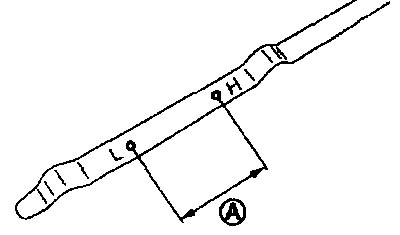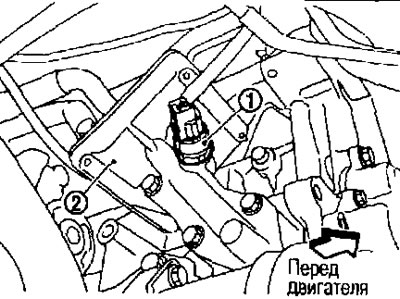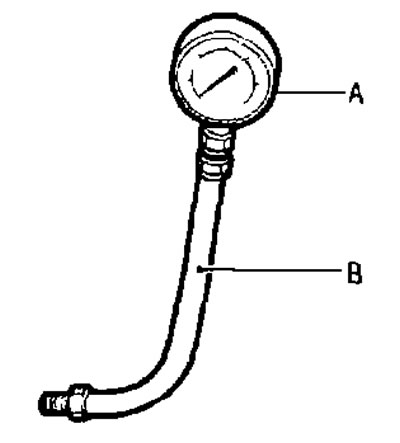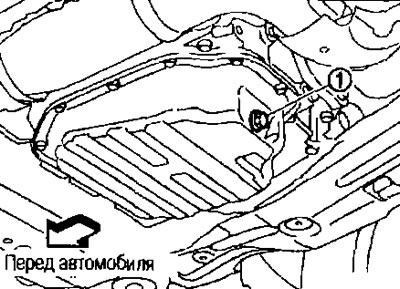Examination
Oil level
Note. Before starting the engine, check the oil level with the vehicle level. If you have already started the engine, turn it off and wait 10 minutes before starting the test.
1. Remove the oil dipstick and wipe it clean.
2. Insert the oil dipstick and make sure the oil level is within the range (A) shown in the figure.

3. If it is outside this range, bring it to normal.
Oil contamination
- Check the oil for white cloudiness or significant contamination.
- If the oil becomes cloudy and white, it is very likely that engine coolant has entered the oil. Find the cause and fix it.
Oil leak
Check for oil leaks around the following areas:
- oil pan (top and bottom);
- oil pan drain plug;
- low oil pressure warning light switch;
- oil filter;
- oil cooler;
- cover and solenoid valve of the intake valve timing control mechanism;
- front cover;
- contact surface between the cylinder head and the valve cover;
- contact surface between the cylinder block and the lower cylinder block;
- contact surface between the cylinder block and the cylinder head;
- crankshaft oil seals (front and back).
Checking oil pressure
Attention:
- Avoid getting burned by hot engine oil.
- Check the oil pressure in position «R» (on models with CVT) or in neutral position (on models with manual transmission), firmly applying the parking brake.
1. Check the oil level. See above.
2. Using a wrench, remove the engine protection from the bottom.
3. Disconnect the connector from the low oil pressure warning lamp switch (1) and unscrew the switch using the long head (suitable special tools).

2. Oil cooler.
Attention. Do not drop or hit the low oil pressure warning light switch.
4. Connect the oil pressure gauge (special tool: ST25051001) (A) and hose special tool: ST25052000 (IN).

5. Start the engine and warm it up to normal operating temperature.
6. Check the oil pressure with the engine running without load.
Note. When the engine oil temperature is low, the oil pressure increases.
Engine oil pressure: See paragraph below. «Technical data and specifications».
- If the pressure is significantly different from the norm, check for oil leaks in the engine oil passage and oil pump.
7. Upon completion of the check, screw the low oil pressure warning lamp switch into place as follows
- Remove old sealant from the switch and from the mounting hole on the engine.
- Apply sealant and tighten the switch to the required torque.
- Use branded sealant or equivalent.
Tightening torque: See below.
- After warming up the engine, check for oil leaks while the engine is running.
Drain
Attention:
- Avoid getting burned by hot engine oil.
- Prolonged and frequent contact with used motor oil can cause skin cancer. Try to avoid contact of used oil with your skin. If the oil does get on your skin, you should wash your hands as quickly as possible with soap or detergent.
1. Warm up the engine and check for oil leaks from engine components. See above.
2. Stop the engine and wait 10 minutes.
3. Loosen the filler cap.
4. Remove the plug (1) from the drain hole and drain the engine oil.

Refueling
1. Screw the plug into the drain hole using a new washer. See chapter «Mechanical part of the engine».
Attention. Clean the drain plug and screw it in with a new washer.
Tightening torque. See chapter «Mechanical part of the engine».
2. Fill with fresh engine oil. Oil specifications and viscosity See chapter «Maintenance».
Oil filling container. See paragraph below. «Technical data and specifications».
Attention:
- The filling capacity depends on the oil temperature and draining time. Use these specifications as a guide only.
- To reliably determine the amount of oil in the engine, use an oil dipstick.
3. Warm up the engine and check for oil leaks in the areas around the drain plug and oil filter.
4. Stop the engine and wait 10 minutes.
5. Check the oil level. See above.